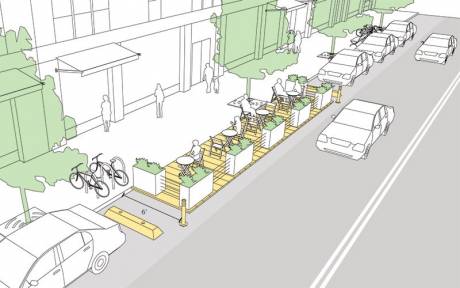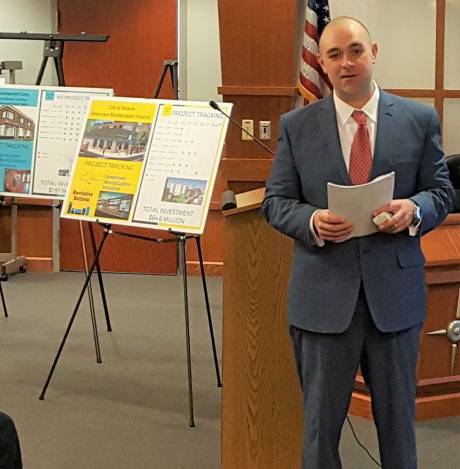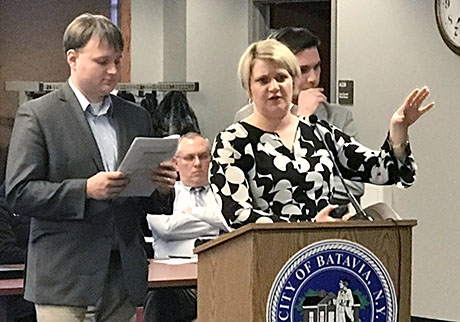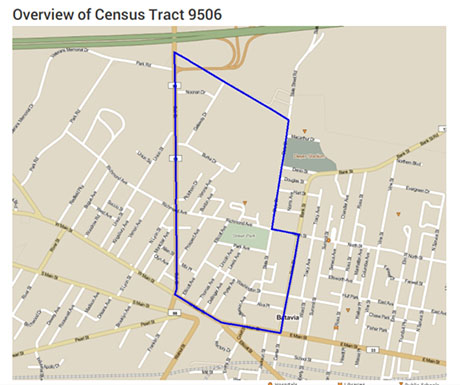Project manager says Main Street 56 Dance Company will open sometime in June
In modern and jazz dance terms, the Batavia Players’ Main Street 56 Dance Company is just a “fan kick” away from the start of a new era at its new home at 35 City Centre.
Project Manager David Ciurzynski, of Ciurzynski Consulting LLC, of Attica, today said that the $417,000 award from the New York Main Street Anchor Grant Program to the Main Street 56 Theater and Dance Company project likely will allow the dance studio portion to open for business sometime in June.
“(The funding) is going to allow us to design and build a new façade on the front of the building so you won’t have that old ‘mall’ look, and it will also help us with the lobby space in the areas that we had cut back on our design to fit into our budget,” Ciurzynski said. “So, it really balances out the project and allows us to complete it properly.”
Ciurzynski said interior drawings are almost done and building permits for the dance studio have been received.
“People at the mall may have seen some activity there as we have put up the drywall and installed some doors for the dance studio,” he said. “With that being said, we’re hoping to have it open in June.”
As far as the theater is concerned, he said design development drawings are expected by the end of the week “so we can start looking at finalizing the budget for that, getting permit review and get that bid out.”
Ciurzynski said he anticipates the theater being complete by the end of the year.
The Batavia Players has hired Thompson Builds of Churchville as the general contractor.
The project is being funded by a state Downtown Revitalization Award of $701,750, the recent NY Main Street Anchor Grant and a fundraising campaign.
“Part of the budget is being covered by volunteer labor as well,” he said. “It’s getting easier because we have funding; work is getting done. This is a real thing now for people.”
Ciurzynski said his involvement in the project has opened his eyes to the Batavia Players’ contributions to the community.
“It has been just an honor to work for these people. I never realized how many children and how many families that they reach through their educational and dance programs,” he said. “These are programs that people will be able to use during the reduced school times for their art classes for school. It’s really a big benefit to have this right in the middle of our city.”
In related action, the Batavia Development Corp. Board of Directors this morning formally approved acceptance of the $417,000 grant, which is awarded through the Housing Trust Fund Corporation and the Office of Community Renewal, to rehabilitate 14,000 square feet of vacant space for the theater.
Healthy Living Campus Update
Ciurzynski is representing Rochester Regional Health and the GLOW YMCA on the development of the Healthy Living Campus in Downtown Batavia – a $22.5 million project funded by a $4 million DRI award, $7.5 million grant from the Statewide Health Care Facility Transformation Program II and a local fundraising campaign.
He said the project is at the design development stage, which means that the submittal of site plans to county and city planning boards isn’t too far away.
“We need to make sure we have all the funding sources in place … and also the material pricing and availability,” he offered, adding that he hopes that work will be bid out and some construction will start this fall. “We will try to balance that all out with the market, which is extremely difficult right now to do on a large project like that. Steel and copper pricing is unstable right now, and we just have to make sure that we can minimize its effect on our project.”
Ciurzynski said the plan is to take down Cary Hall on East Main Street, construct a new building and move the current YMCA operation into it.
“After that, we’ll take down the old Y,” he said. “It’s a good 12 to 15 months’ worth of construction for the new Y. If we start late this year, it will be late 2022 or early 2023 before that building comes down.”
He also said he would like to see the Office for the Aging (which is attached to the current YMCA) be a part of the Healthy Living Campus.
“We’re in talks with the Office for the Aging but right now the plan is to keep it where it is. That’s a work in progress. We would have to develop a plan to separate the building, and put in new utilities to make sure it is operational,” he said.
“The hope would be that we could find a way to incorporate them into the overall campus and save people money and be able to provide the same services and make the buildings work all at the same time.”
Calling it a “dynamic process” due to the fact that the venture includes two nonprofit organizations and the City of Batavia, Ciurzynski said it will take “time, patience and understanding to bring all the parts and pieces together.”
“But when we’re done, it is going to be a very transformational program in the center of our city that will provide much for health care and wellness for youth and seniors,” he said.
Previous: Healthy Living Campus consultant: Access to services at forefront of large-scale Batavia projects







